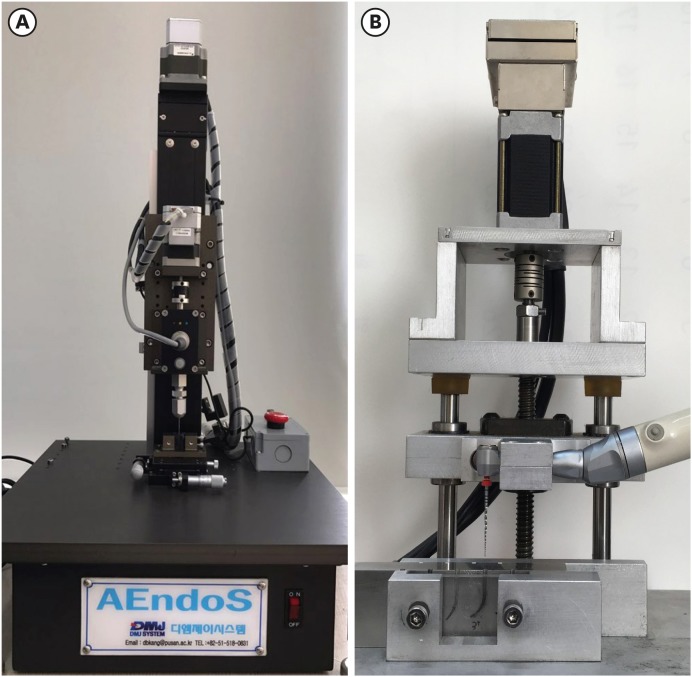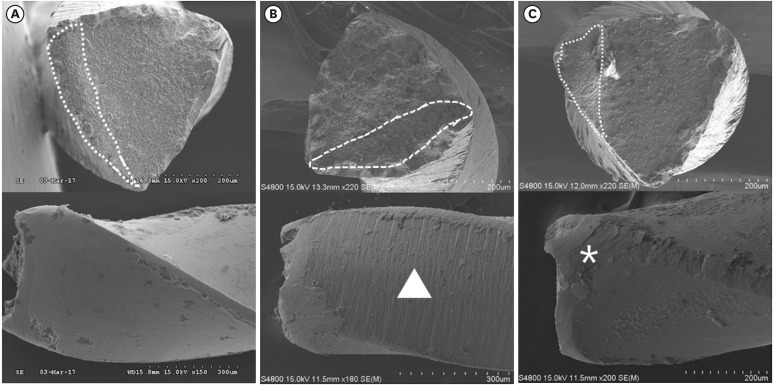Restor Dent Endod.
2017 Aug;42(3):216-223. 10.5395/rde.2017.42.3.216.
Effect of surface treatment on the mechanical properties of nickel-titanium files with a similar cross-section
- Affiliations
-
- 1Department of Conservative Dentistry, Pusan National University School of Dentistry and Dental Research Institute, Yangsan, Korea. golddent@pusan.ac.kr
- KMID: 2386775
- DOI: http://doi.org/10.5395/rde.2017.42.3.216
Abstract
OBJECTIVES
The aim of this study was to compare the mechanical properties of various nickel-titanium (NiTi) files with similar tapers and cross-sectional areas depending on whether they were surface-treated.
MATERIALS AND METHODS
Three NiTi file systems with a similar convex triangular cross-section and the same ISO #25 tip size were selected for this study: G6 (G6), ProTaper Universal (PTU), and Dia-PT (DPT). To test torsional resistance, 5 mm of the straightened file's tip was fixed between polycarbonate blocks (n = 15/group) and continuous clockwise rotation until fracture was conducted using a customized device. To evaluate cyclic fatigue resistance, files were rotated in an artificial curved canal until fracture in a dynamic mode (n = 15/group). The torsional data were analyzed using 1-way analysis of variance and the Tukey post-hoc comparison test, while the cyclic fatigue data were analyzed using the Mann-Whitney U test at a significance level of 95%.
RESULTS
PTU showed significantly greater toughness, followed by DPT and G6 (p < 0.05). G6 showed the lowest resistance in ultimate torsional strength, while it showed a higher fracture angle than the other files (p < 0.05). In the cyclic fatigue test, DPT showed a significantly higher number of cycles to failure than PTU or G6 (p < 0.05).
CONCLUSIONS
Within the limitations of this study, it can be concluded that the torsional resistance of NiTi files was affected by the cross-sectional area, while the cyclic fatigue resistance of NiTi files was influenced by the surface treatment.
MeSH Terms
Figure
Reference
-
1. Schäfer E, Schulz-Bongert U, Tulus G. Comparison of hand stainless steel and nickel titanium rotary instrumentation: a clinical study. J Endod. 2004; 30:432–435. PMID: 15167474.2. Peters OA. Current challenges and concepts in the preparation of root canal systems: a review. J Endod. 2004; 30:559–567. PMID: 15273636.
Article3. Cheung GS, Liu CS. A retrospective study of endodontic treatment outcome between nickel-titanium rotary and stainless steel hand filing techniques. J Endod. 2009; 35:938–943. PMID: 19567311.
Article4. Sonntag D, Guntermann A, Kim SK, Stachniss V. Root canal shaping with manual stainless steel files and rotary Ni-Ti files performed by students. Int Endod J. 2003; 36:246–255. PMID: 12702118.
Article5. Glossen CR, Haller RH, Dove SB, del Rio CE. A comparison of root canal preparations using Ni-Ti hand, Ni-Ti engine-driven, and K-Flex endodontic instruments. J Endod. 1995; 21:146–151. PMID: 7561658.6. Sattapan B, Nervo GJ, Palamara JE, Messer HH. Defects in rotary nickel-titanium files after clinical use. J Endod. 2000; 26:161–165. PMID: 11199711.
Article7. Alapati SB, Brantley WA, Svec TA, Powers JM, Nusstein JM, Daehn GS. SEM observations of nickel-titanium rotary endodontic instruments that fractured during clinical use. J Endod. 2005; 31:40–43. PMID: 15614004.
Article8. Cho OI, Versluis A, Cheung GS, Ha JH, Hur B, Kim HC. Cyclic fatigue resistance tests of nickel-titanium rotary files using simulated canal and weight loading conditions. Restor Dent Endod. 2013; 38:31–35. PMID: 23493583.
Article9. Cheung GS. Instrument fracture: mechanisms, removal of fragments, and clinical outcomes. Endod Topics. 2007; 16:1–26.
Article10. Tsujimoto M, Irifune Y, Tsujimoto Y, Yamada S, Watanabe I, Hayashi Y. Comparison of conventional and new-generation nickel-titanium files in regard to their physical properties. J Endod. 2014; 40:1824–1829. PMID: 25266465.
Article11. Kim HC, Kim HJ, Lee CJ, Kim BM, Park JK, Versluis A. Mechanical response of nickel-titanium instruments with different cross-sectional designs during shaping of simulated curved canals. Int Endod J. 2009; 42:593–602. PMID: 19467053.
Article12. Kwak SW, Ha JH, Lee CJ, El Abed R, Abu-Tahun IH, Kim HC. Effects of pitch length and heat treatment on the mechanical properties of the glide path preparation instruments. J Endod. 2016; 42:788–792. PMID: 26972489.
Article13. Shen Y, Zhou HM, Zheng YF, Peng B, Haapasalo M. Current challenges and concepts of the thermomechanical treatment of nickel-titanium instruments. J Endod. 2013; 39:163–172. PMID: 23321225.
Article14. Kuhn G, Tavernier B, Jordan L. Influence of structure on nickel-titanium endodontic instruments failure. J Endod. 2001; 27:516–520. PMID: 11501589.
Article15. Yum J, Cheung GS, Park JK, Hur B, Kim HC. Torsional strength and toughness of nickel-titanium rotary files. J Endod. 2011; 37:382–386. PMID: 21329826.
Article16. Schneider SW. A comparison of canal preparations in straight and curved root canals. Oral Surg Oral Med Oral Pathol. 1971; 32:271–275. PMID: 5284110.
Article17. Pruett JP, Clement DJ, Carnes DL Jr. Cyclic fatigue testing of nickel-titanium endodontic instruments. J Endod. 1997; 23:77–85. PMID: 9220735.
Article18. Panitvisai P, Parunnit P, Sathorn C, Messer HH. Impact of a retained instrument on treatment outcome: a systematic review and meta-analysis. J Endod. 2010; 36:775–780. PMID: 20416418.
Article19. McGuigan MB, Louca C, Duncan HF. The impact of fractured endodontic instruments on treatment outcome. Br Dent J. 2013; 214:285–289. PMID: 23518972.
Article20. Xu X, Eng M, Zheng Y, Eng D. Comparative study of torsional and bending properties for six models of nickel-titanium root canal instruments with different cross-sections. J Endod. 2006; 32:372–375. PMID: 16554216.
Article21. Park SY, Cheung GS, Yum J, Hur B, Park JK, Kim HC. Dynamic torsional resistance of nickel-titanium rotary instruments. J Endod. 2010; 36:1200–1204. PMID: 20630299.
Article22. Wycoff RC, Berzins DW. An in vitro comparison of torsional stress properties of three different rotary nickel-titanium files with a similar cross-sectional design. J Endod. 2012; 38:1118–1120. PMID: 22794218.23. Baek SH, Lee CJ, Versluis A, Kim BM, Lee W, Kim HC. Comparison of torsional stiffness of nickel-titanium rotary files with different geometric characteristics. J Endod. 2011; 37:1283–1286. PMID: 21846549.
Article24. Yao JH, Schwartz SA, Beeson TJ. Cyclic fatigue of three types of rotary nickel-titanium files in a dynamic model. J Endod. 2006; 32:55–57. PMID: 16410070.
Article25. Li UM, Lee BS, Shih CT, Lan WH, Lin CP. Cyclic fatigue of endodontic nickel titanium rotary instruments: static and dynamic tests. J Endod. 2002; 28:448–451. PMID: 12067126.
Article26. Ray JJ, Kirkpatrick TC, Rutledge RE. Cyclic fatigue of EndoSequence and K3 rotary files in a dynamic model. J Endod. 2007; 33:1469–1472. PMID: 18037061.
Article27. Cheung GS, Shen Y, Darvell BW. Does electropolishing improve the low-cycle fatigue behavior of a nickel-titanium rotary instrument in hypochlorite? J Endod. 2007; 33:1217–1221. PMID: 17889693.
Article28. Kim HC, Yum J, Hur B, Cheung GS. Cyclic fatigue and fracture characteristics of ground and twisted nickel-titanium rotary files. J Endod. 2010; 36:147–152. PMID: 20003955.
Article
- Full Text Links
- Actions
-
Cited
- CITED
-
- Close
- Share
- Similar articles
-
- The effect of heat sterilization on the surface topography and the tensile properties in various nickel titanium wires including a Korean product
- Mechanical properties of nickel titanium and steel alloys under stress- strain test
- Mechanical and geometric features of endodontic instruments and its clinical effect
- Effects of recycling on the mechanical properties and the surface topography of Nickel-Titanium alloy wires
- Effects of heat treatment on the load-deflection properties of nickel-titanium wire




